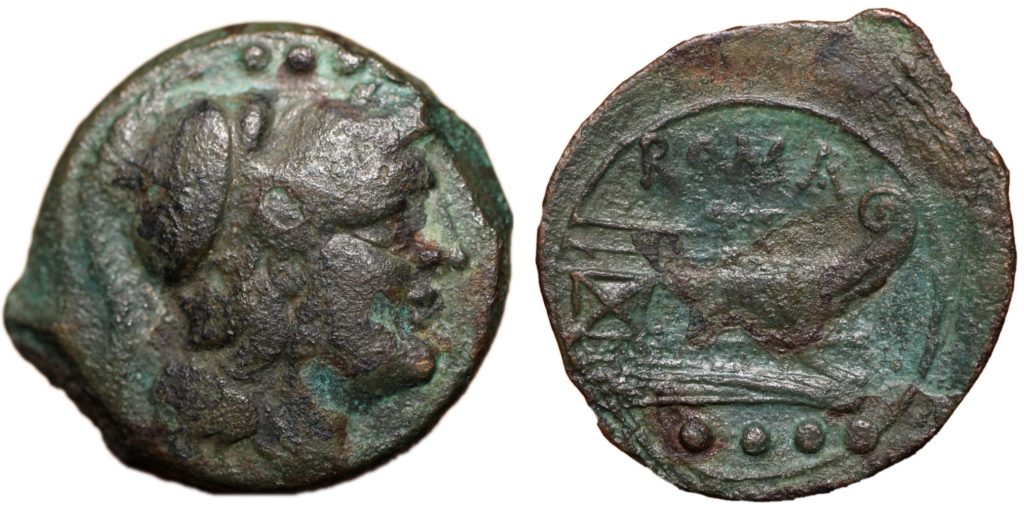
The coin above is a triens, worth a third of an as. The term triens always takes a little mental leap for me, because it looks – etymologically speaking – like you’d anticipate there being three pellets on a triens, but there are four. This is because the ○○○○ symbolise four unciae. Since an uncia is one twelfth of an as, four of them constitute four twelfths, which is a third. Thus the ○○○○ denote four unciae (of the 12 needed for an as), making it a third of an as.
Minerva appears rather formidable to me on this coin, but then, not as formidable as she might appear:
ἀμφὶ δ᾽ ἄρ᾽ ὤμοισιν βάλετ᾽ αἰγίδα θυσσανόεσσαν
δεινήν, ἣν περὶ μὲν πάντῃ Φόβος ἐστεφάνωται,
ἐν δ᾽ Ἔρις, ἐν δ᾽ Ἀλκή, ἐν δὲ κρυόεσσα Ἰωκή,
ἐν δέ τε Γοργείη κεφαλὴ δεινοῖο πελώρου
δεινή τε σμερδνή τε, Διὸς τέρας αἰγιόχοιο.
Around her shoulders she threw the fearful
Tasselled aegis, ringed all around with Terror,
and on it Discord, on it Strength, on it chilling Pursuit,
and on it the head of the terrible, monstrous Gorgon,
terrible and dreadful, a sign of Zeus aegis-bearer.
Homer Iliad 5.738-42.
Two things interest me about this coin. The first is the last of those pellets on the reverse. It is outside the border. When the die-cutter constructed this image, he must probably have started from defining his canvas, as it were, by scribing the outer ring. The naval imagery is nicely placed, centrally, with the prow well-fitted into the image without crowding. ROMA seems to fit in well. So why do the pellets start too far to the right? Did the die-cutter plan poorly? Did he think for a moment he was making a quadrans and only needed three? The first three ○ look well balanced, after all. The art historian in me would love to think that there was some meaning in his decision to have the pellet emerging from the frame, but alas I think it is likely that this was just a mistake. It is not normative for this type of coin.

The second thing that interests me is the overall shape of the flan. The coin is shaped like a very squat conical frustrum. This and the presence of the bulges away from the circular visible on the coin must reflect the process of casting the blanks. But it all seems rather rough and ready; the blank has been smushed with force, but it still isn’t exactly perfectly formed. This is especially obvious when compared to – say – the Ptolemaic bronzes with their fastidious insistence on precise circularity and the almost showy presence of the centring-divots which trumpet their precision. It all reminds me of the way the Romans prided themselves on being rough-and-ready, practical and careful, not dainty or preening.
